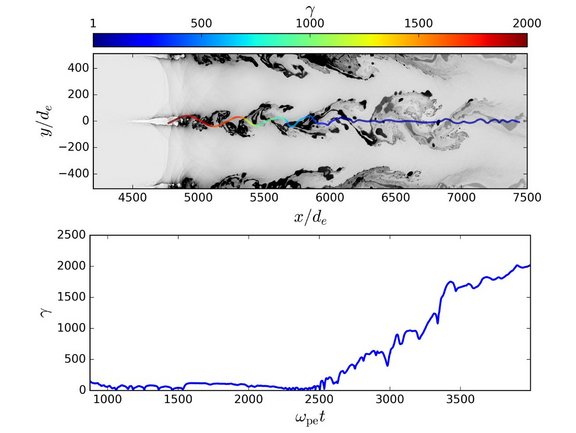Pulsars, i.e. rapidly rotating neutron stars, are surrounded with light, strongly magnetized, ultra-relativistic winds of electron-positron pairs. The interaction of these winds with their surrounding medium leads to the formation of a shock, or “termination shock”, where the ultra-relativistic wind is decelerated and isotropized, and forms a pulsar wind nebula. The latter often shines brightly in non-thermal X-rays and gamma-rays. For instance, the emission from the well-known Crab Nebula shows that electrons are accelerated there efficiently up to extreme energies in the PeV (1015 eV) range. The termination shock had long been suspected to be the acceleration site for these particles, but, until now, no scenario had been able to explain such extreme particle acceleration.
Recently, Gwenael Giacinti, a member of the Astrophysical Plasma Theory Group of Brian Reville and Non-Thermal Astrophysics Division of Jim Hinton at MPIK, together with Benoît Cerutti (IPAG, Grenoble, France) have shed new light on this acceleration mechanism [1]. The authors’ ab-initio, particle-in-cell simulations of the plasma in the shock region have revealed a new mechanism that can accelerate particles efficiently to very high energies. The simulations show that the large-scale structure of the magnetic field in the shock region plays a crucial role in the formation of large-scale turbulence, which dissipates and accelerates particles at smaller scales. A surprising prediction of this numerical model is the formation of a plasma cavity located on the shock front at the equator, and where the highest-energy particles are concentrated – reminiscent of earlier findings [2]. These particles may hold the key to the mysterious gamma-ray flares observed by the Fermi and AGILE satellites from the Crab Nebula. This new acceleration mechanism may also be at work in other extreme relativistic astrophysical environments, such as at the termination shocks of active galactic nuclei or in gamma-ray bursts.
Original publication:
[1] A global model of particle acceleration at pulsar wind termination shocks, Benoît Cerutti & Gwenael Giacinti, Astronomy & Astrophysics, 642, A123 (2020), DOI: 10.1051/0004-6361/202038883
[2] Acceleration of X-ray Emitting Electrons in the Crab Nebula, Gwenael Giacinti & John G. Kirk, Astrophys. J. 863, 18 (2018), DOI: 10.3847/1538-4357/aacffb
